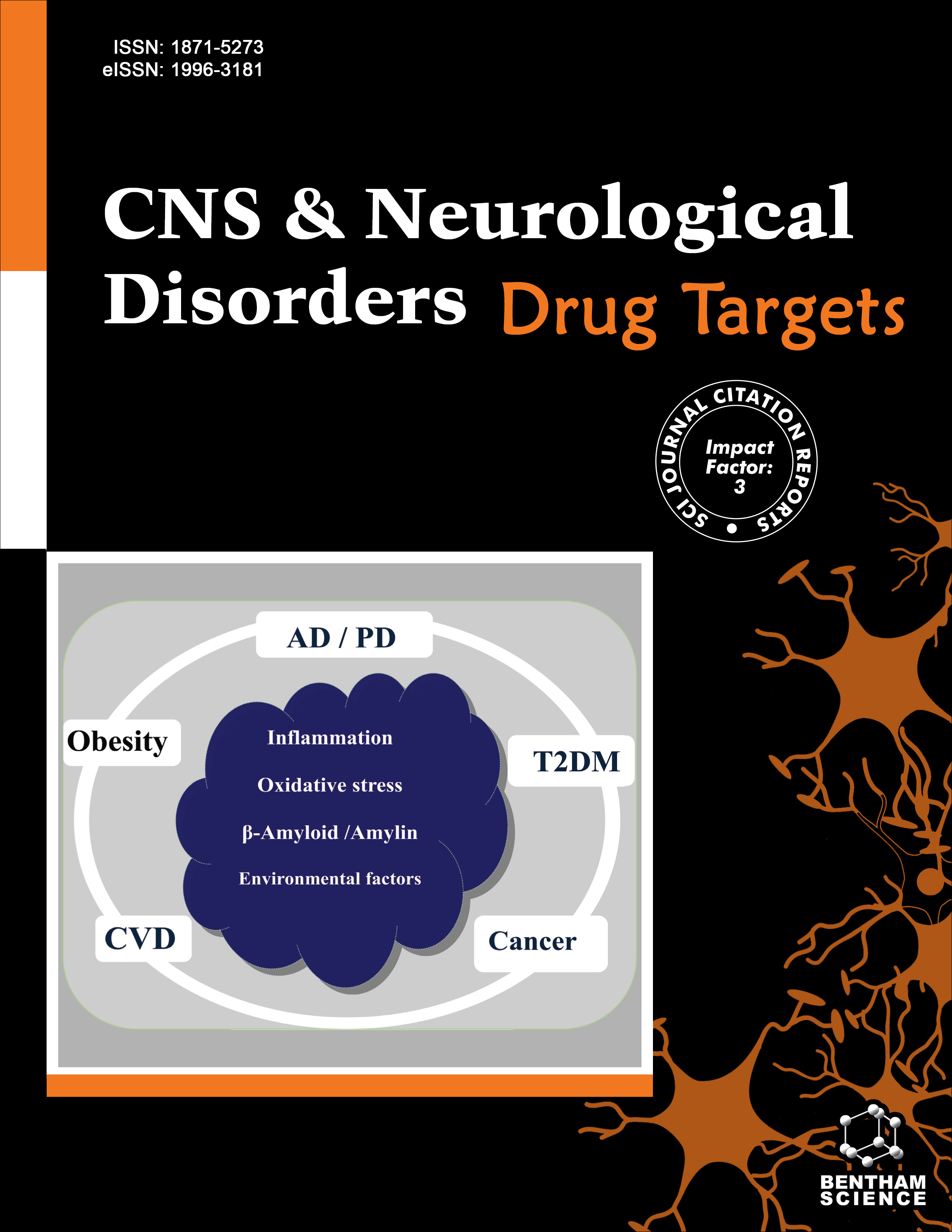- Home
- A-Z Publications
- CNS & Neurological Disorders - Drug Targets (Formerly Current Drug Targets - CNS & Neurological Disorders)
- Previous Issues
- Volume 6, Issue 1, 2007
CNS & Neurological Disorders - Drug Targets (Formerly Current Drug Targets - CNS & Neurological Disorders) - Volume 6, Issue 1, 2007
Volume 6, Issue 1, 2007
-
-
Editorial [ Hot Topic: Therapeutic Opportunities in the Treatment of Sleep Disorders (Guest Editor: Margaret Bradbury) ]
More LessSleep disorders, including chronic insomnia, continue to be considerably under-treated medical conditions. A recent poll conducted by the National Sleep Foundation [1] estimated that a quarter of the respondents considered their sleep poor to fair. When quizzed by symptoms, even more individuals qualified for an insomnia diagnosis. As recently as 2005, a National Institutes of Health State of the Science Conference was c Read More
-
-
-
The Prevalence, Morbidities, and Treatments of Insomnia
More LessInsomnia is a common condition that often is co-morbid with other illnesses. It is associated with significant morbidities, including nighttime distress, impaired cognitive functioning, impaired daytime functioning, and increased risk of accidents. People with insomnia utilize healthcare services more often than those without insomnia, and they are at greater risk for the development of certain health problems; most notably psychiatri Read More
-
-
-
Effects of Psychiatric Medications on Sleep and Sleep Disorders
More LessAuthors: Nicholas A. DeMartinis and Andrew WinokurInsomnia is a significant public health concern that has prompted substantial efforts to develop treatment and management strategies. A significant proportion of complaints of insomnia are related to psychiatric conditions such as anxiety disorders and depression, and treatments for these disorders are known to exert both direct and indirect benefits on sleep as well as some negative effects on sleep and sleep physiology. I Read More
-
-
-
Histaminergic Control of Sleep-Wake Cycles: Recent Therapeutic Advances for Sleep and Wake Disorders
More LessAuthors: A. J. Barbier and M. J. BradburyThe role of histaminergic neurotransmission in the promotion of waking has been extensively studied in preclinical species. Appreciation for the role of histamine continues to expand with increasing understanding of the interaction of histamine within the broad network of neuromodulators that regulate sleep and wake. The effects of histamine on waking are transduced through the H1 and the H3 receptors in the central nervous Read More
-
-
-
Neuropeptides as Possible Targets in Sleep Disorders: Special Emphasis on Hypocretin-Deficient Narcolepsy
More LessAuthors: Nobuhiro Fujiki and Seiji NishinoSleep disorders are disturbances of usual sleep patterns or behaviors caused by deregulation of neuronal synchronicity and of the balance of the neurotransmitter system involved in sleep regulation. Insomnia and hypersomnia are frequent sleep disorders, and these are most often treated pharmacologically with hypnotics and wake-promoting compounds. These compounds act on classical neurotransmitter systems, such a Read More
-
-
-
T-Type Calcium Channels and Thalamocortical Rhythms in Sleep: A Perspective from Studies of T-Type Calcium Channel Knockout Mice
More LessAuthors: Jungryun Lee and Hee-Sup ShinSleep is characterized by synchronized electrical activities of the thalamocortical network, which can be identified as the EEG oscillations during sleep. T-type calcium channels have been implicated in the occurrence of sleep waves, and burst firings in the thalamic neurons driven by these channels are known to be essential for modulation of sleep rhythms. Studies showed that α1G T-type calcium channel knockout mice ha Read More
-
-
-
Genomic and Proteomic Approaches Towards an Understanding of Sleep
More LessAuthors: Bruce F. O'Hara, Jane Ding, Rebecca L. Bernat and Paul FrankenThe basic functions of sleep are still unclear, however, recent advances in genomics and proteomics have begun to contribute to our understanding of both normal and pathological sleep. In this review, we focus primarily on normal sleep and wake that have been studied in model organisms such as mice. Mice have been especially valuable since many different inbred strains exist that differ in sleep-related traits, and genes can be Read More
-
-
-
Erratum
More LessBy PublishersDue to an over look on part of the authors, the title of the article “Density is Density - On the Relation Between Quantity of T-Type Ca2+ Channels and Neuronal Electrical Behavior”, published in the journal CNS and Neurological Disorders-Drug Targets, Volume 5, Issue 6, December 2006, pg. 655-62 was printed incorrectly in the article. The correct title is “Density is Destiny - On the Relation Between Quantity of T-Type Ca2+ C Read More
-
Volumes & issues
-
Volume 24 (2025)
-
Volume 23 (2024)
-
Volume 22 (2023)
-
Volume 21 (2022)
-
Volume 20 (2021)
-
Volume 19 (2020)
-
Volume 18 (2019)
-
Volume 17 (2018)
-
Volume 16 (2017)
-
Volume 15 (2016)
-
Volume 14 (2015)
-
Volume 13 (2014)
-
Volume 12 (2013)
-
Volume 11 (2012)
-
Volume 10 (2011)
-
Volume 9 (2010)
-
Volume 8 (2009)
-
Volume 7 (2008)
-
Volume 6 (2007)
-
Volume 5 (2006)
Most Read This Month
Article
content/journals/cnsnddt
Journal
10
5
false
en

Most Cited Most Cited RSS feed
-
-
A Retrospective, Multi-Center Cohort Study Evaluating the Severity- Related Effects of Cerebrolysin Treatment on Clinical Outcomes in Traumatic Brain Injury
Authors: Dafin F. Muresanu, Alexandru V. Ciurea, Radu M. Gorgan, Eva Gheorghita, Stefan I. Florian, Horatiu Stan, Alin Blaga, Nicolai Ianovici, Stefan M. Iencean, Dana Turliuc, Horia B. Davidescu, Cornel Mihalache, Felix M. Brehar, Anca . S. Mihaescu, Dinu C. Mardare, Aurelian Anghelescu, Carmen Chiparus, Magdalena Lapadat, Viorel Pruna, Dumitru Mohan, Constantin Costea, Daniel Costea, Claudiu Palade, Narcisa Bucur, Jesus Figueroa and Anton Alvarez
-
-
-
- More Less

